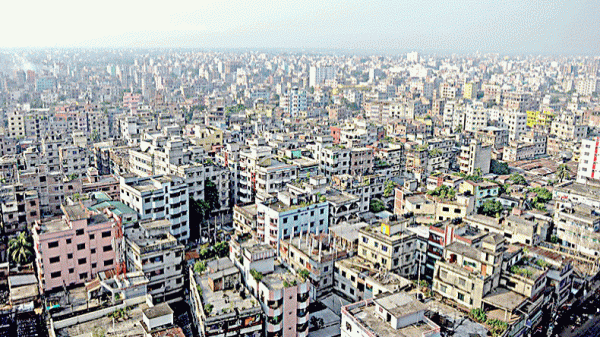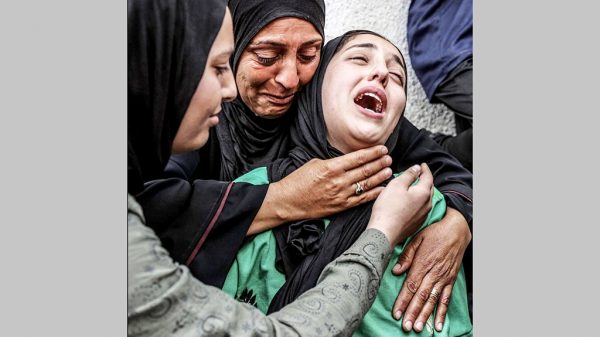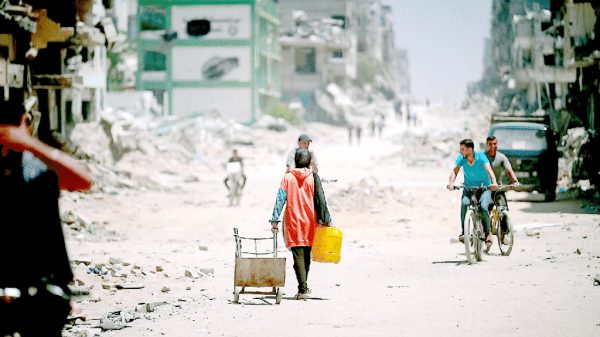For life-sustaining space

LIFE unfolds in space, a proxy of nature, with life-sustaining capacities. Abstract figures such as the GDP growth, poverty reduction rate, foreign reserves, etc keep us spellbound by not revealing what roles the urban-rural spaces play with what consequences in an emerging urban world. This growth-driven development path is underpinning an urban primacy, spearheaded by Dhaka-centricity, which compromises life-sustaining capacities of space. The outbreak of COVID-19 and the battering of we coastal districts by cyclone Amphan show that the spaces we live in fall short of sustaining lives. How we think for space to accommodate and feed an increasing national population with the least per capita land in the world remains a challenge.
Space is also a means of creating disparity as market-driven neoliberal development policies unfold into practices. We explicate how the local urban elite has extracted a huge surplus by denying the well-being of Dhaka and its rural hinterland; their web of extraction links to the urban north and spreads across rural-urban Bangladesh. They and their infrastructure of extraction stay buffered from most natural disasters and climate change impacts while the internally displaced migrants kept pouring into Dhaka. At the outbreak of COVID-19, a few elite flew out of Dhaka to the urban north for safe refuge while the masses continue returning to their rural crisis sink. Space, we believe, ought to be liberating and life-sustaining. The alternative to the current ‘urbanisation of extraction’ is a path to ensure a life-sustaining space across rural-urban Bangladesh. We reflect on the current practice by asking what rationale underpins the hegemonic spatiality of urban primacy and what tangible benefits accrue from it and for whom. Reflection is a step to our way forward.
Global urban system
WE NOW live on an urban planet. Advances in the Earth Systems Sciences and Urban Sciences have had provided knowledge for the United Nation’s adopting ‘The New Urban Agenda’ and ‘Sustainable Development Goals’ by 2030; these global policies are set to steer humanity’s sustainable passage through the anthropocene era. An urban primacy becomes a means for sustainable planetary resources use for a bourgeoning global urban population: the recent 3.3 billion will be 5 billion by 2030. An estimated 80 per cent of this growth will be in Asian and African countries. Although cities today cover only 20 per cent of the earth’s surface, they consume 75 per cent of the earth’s material resources while contributing nearly 90 per cent to global gross value. Existing large cities will continue expanding as future services and infrastructures provision will be less costly in new or small towns. Cities, especially the largest ones, are key for the urban transition to sustainability. Current wisdom argues that the challenge of a sustainable urban planet will be won or lost in cities of the global south.
Now there is a catch. Urban science has predicted the global urban future by modelling reliable big data derived from the global north and a few other cities in developed countries such as China, Japan, and South Korea. To what extent urban future assumptions and predictions will apply to cities in the global south remains an open question. Moreover, urban features and experiences not only differ between the global north and the south but also among cities in the global south. Measures for the future urban in the global south cities, therefore, rest beyond that elusive size that fits all.
With an urban primacy, will the rural cease to exist? No. Urban areas depend on rural hinterlands, among others, for their supply of food. Under globalisation, this rural-urban supply-consumption linkage has become a cross-border phenomenon. London city, for example, imports 80 per cent of its food from overseas; the Netherlands requires four times its geographic area for a steady supply of foods. Given this trend, we can fairly argue that the urban north makes the rural south its subservient other in the hierarchical, networked and nested global urban system. Global urban transition to sustainability has to address this asymmetric cross-continent urban-rural dependency. Bangladesh, for example, is not out of this matrix; it transformed agricultural lands in the coastal districts long ago for shrimp farming for the consumption of the urban north. Staple foods for our domestic consumption are mostly home-grown, yet we too import foods to meet the local demands. As no exception to the cities in the north, trans-border food supply also feeds the urban areas in Bangladesh; this food supply chain will persist with priority so long as the 28 per cent national population living in the urban areas contribute 65 per cent to the GDP.
The urban and rural local transactions with the urban global north are the two trajectories of the growth-driven development under globalisation. Selective explication of these transactions in our urban-rural space below shows whether they comply or contradict the ways of implementing a sustainable global urban future.
Urban local-urban north
DHAKA claims urban primacy for contributing 40 per cent to the GDP with 9 per cent of the national population. Dhaka’s high-yield productivity of the non-agricultural livelihood contrasts with the low-productivity of the rural agricultural livelihood where 40 per cent of the total labour force contributed 13 per cent to the GDP in 2018. Economic organisation in Bangladesh explains a deeply entrenched formal-informal binary, which underpins the formal Dhaka’s transaction with the urban north through dependent facilitation by the urban informal Dhaka.
The formal sector in Bangladesh provides only 12.6 per cent employments mostly within urban areas, especially, in Dhaka. Yet the performance and subsistence depend on produces and services by a staggering 87.4 per cent informal sector employment in Bangladesh. Dhaka’s 75 per cent population working in the urban informal sector during the early 1980s increased little in percentages but expanded exponentially in absolute numbers with today’s 17 million people. Urbanisation in Bangladesh has, therefore, not brought industrialisation but intensified the informalisation of both the urban formal and informal sectors. Features of informal livelihoods like low income, insecure jobs, unsafe workplace, poor health and unhealthy housing are also evident in the formal sector employment. In short, urban informal workers are Dhaka’s largest vulnerable groups, foot-loose tenants. Dhaka’s claim on the GDP contribution sounds hollow by its perpetuating a dependent formal-informal relationship and fails to ensure urban liveability with access to basic services, safety and security to its low-income vulnerable citizens.
We continue privileging the formal sector, albeit, by often citing the ‘development surprise’ for noting an observed incongruity between economic growth and good governance in Bangladesh. An unnoticed ‘spatial paradox’ also runs parallel: space as a factor of production goes without improvements through the secondary and tertiary circuits of capital. Local capitalists extract profits in the primary production but do not invest respectively either in real estates or in the improvements of labour productivity, for example, through workers housing. Dhaka aspires to emulate Singapore only in words without materialising the experiences of the south-east Asian countries: productivity of human capital is harnessed best by an improving urban built environment.
The urban informalisation process began with an unholy nexus of greed-power-corruption. Businesspeople’s becoming politicians or aligning with the ruling political party caused irreversible environmental damage to Dhaka’s built environment. Their wealth-power put them above accountability and created a zone of exceptions through deregularisation of the prevailing statutory rules in collusion with a section of the state. Their manipulative bending of rules had been a planned ‘urban informality’, acting as the operating logic of the mode of urbanisation in and around Dhaka. It is well documented how formal private developers illegally grabbed lands, forests and wetlands in and around Dhaka for land speculation. The urban formal sector’s informal plundering of land since the 1990s and public bank loan defaulting from even earlier were justified as means of primitive accumulation of capital.
After the accumulation of capital, Dhaka has also provided land and services, among others, for the flourishing of the apparel sector since the 1980s. Apparel employers have expanded their business while keeping the worker wage at a bare minimum. Dhaka has been dubbed the world’s tailor at the expanse of the apparel worker’s poor income, job insecurity, health and housing. The apparel sector now employs 4.2 million workers of which 80 per cent are in and around Dhaka. With 37 billion export volume, the sector is the highest foreign exchange earner with 83 per cent share while contributing 12 per cent to the GDP. Foreign buyers make as much as 600 per cent profit on a single item at the retail end. A polo shirt, for example, that Bangladesh produces with a cost of $3.30 has a price tag of $42 in a retail shop. This is one among many cases of urban north’s appropriating the land and labour of the global south for meeting the consumer demand of its ‘fast fashion’ culture. The apparel sector has recently reported cancellation of $3.7 billion payment for shipment-ready orders by reputed global brands. Consumers’ savings by not spending in fast fashions in the urban north is inevitable due to their depleted income. Urban north, no doubt, will regroup and reorganise towards a new normal global order. They have built up their financial capacity and health infrastructure to that end. Have we?
While Dhaka has been ranked among the least liveable cities in the world, what role our growth-attained wealth of nation played to make Dhaka liveable? Wealth-X, a New York-based research organisation has reported the number of high net worth population ($1–30 million) in Bangladesh will rise by 11.4 per cent during the 2019–2023 period. Instead of reinvesting the profit in Bangladesh, the Global Financial Integrity reports, they siphoned $5.9 billion out of Bangladesh in 2015 through trade invoicing. A recent report identifies the apparel sector as the leading perpetrator. A Swiss Bank statement of rising bank deposits of Bangladesh origin hints where some of this amount had gone. If this trend continues, the Global Financial Integrity forecasts, money laundering will exceed $14 billion in 2030 and will severely impede the SDGs implementation in Bangladesh. The government, however, prefers to overlook the issue.
Urbanism in Dhaka as particular formal-informal ensemble of city form and functions, and peoples’ mutual socio-economic interactions therein, had all came to an abrupt halt with the pandemic outbreak. This was not unexpected. Public health’s colonial induction has gone into oblivion during modernity’s nation-building scheme. City form developed organically in the unplanned areas without any density considerations and mandatory green allocation. While density multiplied and green totally lost in the illegal, informal settlements without due provision of water, sanitation and drainage. These congested informal settlements could accommodate all households members only during the night; social distancing proved unenforceable during daytime against the spread of the virus.
Decades of neglect has led to the systemic collapse of the city’s public health infrastructure in aid to the pandemic response. Moreover, an absence of central command based on science and knowledge had led to utter confusion. One day, millions of workers were going out of Dhaka in fear of life only to return a few days later for saving their jobs. Apparel employers’ decision to open their factories was in total disregard to the norms of containing the spread of the virus. Social divide in Dhaka has become exposed: people with a stable job and home have become invisible while floating and homeless people have become visible in the public spaces. The former accessed an online option to feed and the latter searched for charity feeding. A meltdown of the normal urban life hit hard the low-income people most; as a measure of saving, families started leaving their rental premises mostly to their villages.
The COVID-19 outbreak has exposed the hidden fault lines over which the vulnerable form and functions of Dhaka have developed since the decolonisation in 1947. Dhaka’s vulnerability to a crisis like the ongoing one links to the successive ruling regimes’ depriving Dhaka dwellers of systemic urban governance and investments in the items of collective consumptions. An absence of citizens’ right to the city — access to housing, health, education, livelihood, mobility, and a liveable environment — appears to have served the elite entrepreneurs’ Dhaka by lowering the costs of labour reproduction. Despite these gross inadequacies, Dhaka’s biggest success has arguably been its receiving millions of rural migrants by providing accommodations and livelihoods. At the outbreak of a pandemic, this success has become Dhaka’s biggest weakness for failing to ensure continued living and livelihood for most of the low-income people, for failing to be a life-sustaining space.
Rural local-urban north
BANGLADESH faces formidable challenges in adapting to the effects of climate change; three vulnerable hotspots are identified in terms of biophysical and socioeconomic factors: the central and western coastal area, the north-western highlands and lands along the main rivers. We would focus on the coastal area due to shortage of space.
Our coastal areas are vulnerable to sea-level rise due to global warming. Sea-level rise in Bangladesh affects the salinity of soil which increased from 1.5 million hectares under salinity in 1973 to three million hectares in 2007. Sea-level rise is a looming threat as the IPCC projected an increase of 14cm by 2030, and 88cm by 2100 compared with the level in 2000. A one-metre increase would inundate 18 per cent land, which with cyclone tidal surge would inundate a further 15 per cent coastal area in Bangladesh. As a result the shrimp farming in the central and western coastal districts for earning foreign currency since the early 1980s would become vulnerable. This practice has eroded the century-old agricultural land, livelihoods and living arrangements. Decades of retaining saline water and encroaching salinity have not only depopulated the rural settlements but also destroyed the ecological balance of the region. People’s increased vulnerability to natural disasters has led to their eventual internal displacement from their ancestral homesteads; 2011 census data confirms this demographic shift of the region.
As the above natural and manmade vulnerabilities are not enough, the government has decided to build coal-fired power plants with multi-billion dollar investments. The power plant at Payra, Patuakhali and Rampal, Bagerhat are specifically located within the world’s largest mangrove forest the Sunderbans. Both these plants will provide power to industries in the newly set economic zones at Mongla, Rampal, Agailjhara, and Bhola Sadar. Payra plant has started test production early this year. Why on earth, we ask, we bring coal to a country that now produces a meagre 0.36 per cent of the global green house gas emissions while ranking 152 among 188 countries. Chinese finance, Indonesian coal and Bangladeshi air would indeed make good chemistry for sustainable global south. Our generosity, compelled by submission to geopolitical coercion, has allowed locating the urban global north’s dirty industry at the expanse of our green Bangla. While we opted for a black path, our Chinese coal merchant and neighbouring India have gone green.
The Sunderbans have repeatedly saved us from the seasonal Bay of Bengal cyclones acting as our first line of defence. Cyclonic winds drop its velocity after the landfall. Decisions to set up coal power plants and industries in the close vicinity of the Sunderbans defying public protests perplex us to understand whose interest matters in a democracy. The most recent category four cyclone Amphan has caused $130 million damage and destroyed 0.22 million houses. Natural protection by the Sunderbans has limited these damages to a minimum. Construction of nearly 10,000 cyclone shelters over the last decades has saved lives with the community-based disaster preparedness. The high wind accompanying tidal surge, however, destroyed ill-prepared embankments, polders, and roads to inundate settlements with saline waters, and make people without shelter, food and livelihoods.
Rural Bangladesh has radically transformed by an occupational diversification from farm to non-farm livelihoods, and innovation through the rise of landless tenancy for contract farming. Yet the urban local as an intermediate agent has put the rural local under a double-edged sword for serving the urban north. It depletes lands, forests and hills, destroys ecological balance, and aggravates climate change effects; on the other hand, it deprives right prices for agricultural produces, endangers rural settlements without protection against natural disasters, and restricts rural access to quality education and services. As a cumulative outcome, rural income drops with agricultural labour scarcity; as a result, cheap rural migrant labours continue arriving at the urban formal and informal sector.
Way forward
THE local urban making of a zone of exceptions has had spread informality from urban to rural areas by draining the life-sustaining capacities of space in its transactions with the urban north. They maintain a north-bound supply chain by deteriorating local liveability, destroying ecological balance and jeopardising food security. As a result, people have become vulnerable without access to health, food, and income during the ongoing pandemic. Yet rise of a rural crisis alongside limitations of resilient cities give us hope to rethink an urban transition to sustainability, especially, at the global south end. Alternative to the current urbanisation of extraction is a path to ensure a life-sustaining space across rural-urban Bangladesh.
Development planning used to intervene in space through the Cartesian separation of nature and people. It dealt with space as natural capital by engineering geophysical vulnerabilities to natural disasters, initiating climate change adaptations, and intervening in human settlements for physical improvements. While it invested in human capital by influencing health, education, and livelihood to peoples’ living a wholesome life. With these focuses, discrete sectoral allocation of resources for space and people followed. People, however, have always made their union with nature for living by adapting to a changing habitat. In the process, people by embodying nature becomes nature to dispense with the Cartesian separation that neo-liberal development planning keeps so close to its heart. With post-pandemic reorganisation in mind, development planning needs to change from acting ‘in’ to ‘for’ space: from a setting for surplus extraction to life sustenance.
Shayer Ghafur is a professor affiliated with the housing and settlement division at the architecture department, BUET.




























Leave a Reply